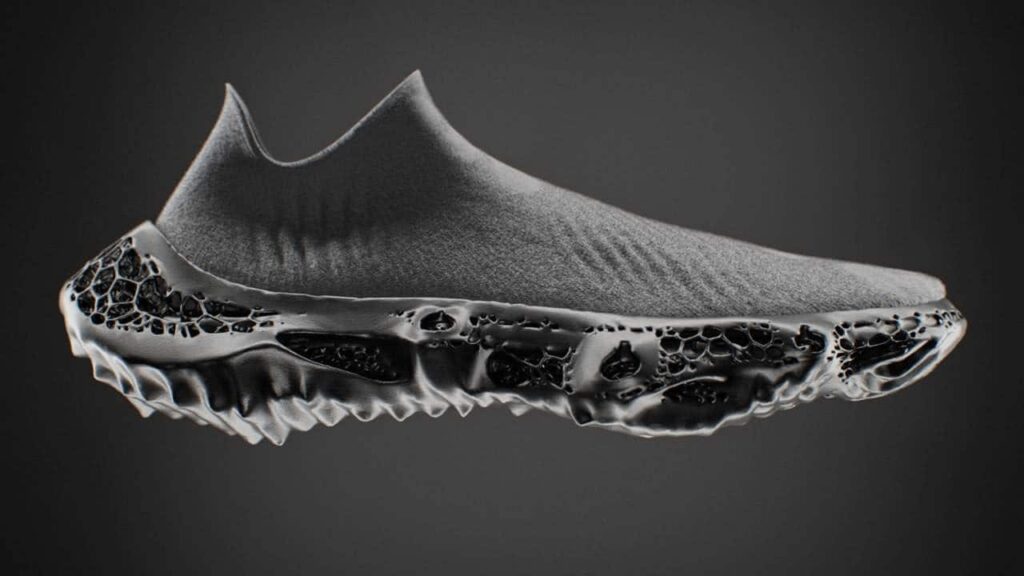At textile trade fair ITMA in Milan, Decathlon, Lonati Group and HP showcased the latest in 3D printed shoes. Decathlon’s latest footwear concept features a midsole and outsole produced using HP’s Multi Jet Fusion (MJF) technology and Lonati’s knitted uppers.
Like most sportswear manufacturers, Decathlon’s mass production occurs in Asia, where multiple parts are assembled. The $11-billion French conglomerate attempts to implement the necessary procedures to combat forced labor and workplace hazards across a sprawling supply chain that spans 44 countries. With automation, Decathlon and similar companies aim to ensure tighter, local control over its manufacturing.
Demonstrating the possibilities, Decathlon partnered with HP and Lonati to produce its latest sports shoe concept. The sole is 3D printed from BASF Ultrasint TPU01 using an HP Jet Fusion 5200 system. The upper is then weaved using a Lonati XT-Machine. Because the shoes are not glued together, they can be recycled more easily, while the use of digital manufacturing technologies not only enables customer personalization but also less reliance on physical stock.

A Decathlon shoe made with HP’s MJF 3D printing technology and a knitted upper made using technology from Lonati Group. Image courtesy of Sportstextiles.com.
Italy’s Lonati has been in the business of making equipment for sock and hosiery weaving for 70 years but began ramping up its efforts in automated upper manufacturing circa 2018. Its GOSHOES line for weaving shoe uppers has resulted in R&D dedicated to developing a complete shoe manufacturing line.
A large driver of the adoption of 3D printing in footwear is the same for manufacturing at large: the need for automation in the face of global economic and social changes. In particular, the drop in accessible fossil fuels has resulted in increased energy prices, which feeds the need to bring manufacturing closer to the point of use. All of this has been exacerbating the overall supply chain crises related to macro events like COVID-19 and the war in Ukraine.
While 3D printed midsoles are beginning to reach the point of mass production, uppers have been traditionally more difficult to tackle. A number of fully 3D printed shoes have attempted to tackle this problem by using foam-like materials and pushing the couture potential of the single-print aesthetic. This could certainly attract younger and hipper consumers, but as that catches on, a more practical approach to uppers would need to be achieved for 3D printed shoes to be economical and marketable.
The answer may be in the form of industrial knitting combined with 3D printing, as demonstrated by Decathlon, Lonati Group and HP. It is likely that, in combination with knitting technologies, that the sector for additively manufacturing foot wear will achieve $4.2 billion in revenues by 2025, according to the “3D-Printed Footwear 2020-2030, an Analysis of the Market Potential of 3D Printing in the Footwear Industry” report from SmarTech Analysis.
Subscribe to Our Email Newsletter
Stay up-to-date on all the latest news from the 3D printing industry and receive information and offers from third party vendors.
You May Also Like
New Report: Semiconductor Industry to See $1.4B in 3D Printing Revenues by 2032
“The semiconductor sector has become the most strategically significant area of global industry.” Truer words are hard to come by when it comes to the modern world, and they are...
Will Photonic-Crystal Lasers Revolutionize 3D Printing?
Powder bed fusion (PBF) for metals and polymers predominantly utilizes lasers as the primary heat source. Some directed energy deposition (DED) technologies also employ lasers, while various vat polymerization methods...
3D Printing Unpeeled: Orbex Investment, IndoMIM and HP, Ultrasonic Waves
INDO-MIM has bought three HP Metal Jet S100 printers, operating two in India and one in Texas. This is a win for HP because the company has deep experience in...
3D Printing Webinar and Event Roundup: April 21, 2024
It’s another busy week of webinars and events, starting with Hannover Messe in Germany and continuing with Metalcasting Congress, Chinaplas, TechBlick’s Innovation Festival, and more. Stratasys continues its advanced training...































